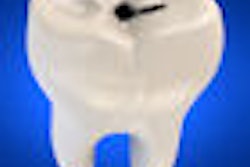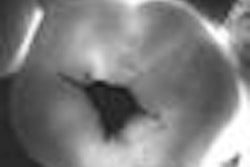A new fluorescence camera developed by a German company compared favorably to the Diagnodent and Diagnodent Pen in detecting caries in primary teeth, according to a study in Lasers in Medical Science (February 16, 2010).
The VistaProof intraoral fluorescence camera (Dürr Dental) uses LEDs to project violet light onto the tooth surface. When illuminated by light at this wavelength, caries-producing bacteria appear red, while healthy enamel appears green. When used in conjunction with the Dürr DBSWIN software, the attached computer monitor displays the lesions and healthy enamel, and provides numerical information on caries activity.
Researchers from the department of pediatric dentistry at the University of São Paulo wanted to compare the reliability of the VistaProof fluorescence camera with that of the Diagnodent and Diagnodent Pen in assessing smooth and occlusal caries lesions in primary teeth, and to determine the influence of the spacer, the protective cover, and air drying on the fluorescence camera readings.
For their in vitro study, they selected 129 primary molars and divided them into two groups: smooth surfaces (n = 68) and occlusal surfaces (n = 61). Two trained examiners performed the evaluations using the VistaProof and Diagnodent devices separately.
One examiner repeated all assessments after one week. Inter- and intraexaminer reproducibilities were calculated from the absolute values derived from the devices using intraclass correlation coefficient (ICC) and Bland-Altman analysis. Pearson correlation was performed among the values obtained with the different devices.
Another examiner performed measurements with the fluorescence camera, varying the size of the spacer, the use of the plastic protective cover, and the drying time (0, 3, and 15 seconds). Wilcoxon's test was used to compare these measurements.
The researchers observed high values of interexaminer ICC with the VistaProof in both experiments. However, the highest intraexaminer ICC for smooth surfaces was found for the Diagnodent (ICC 0.918). A positive correlation among all methods was observed in both studies. Drying for 15 seconds significantly increased the VistaProof readings.
The VistaProof showed high reliability for occlusal and smooth surfaces, similar to the other fluorescence methods tested, the researchers concluded. In addition, prolonged air drying increased the VistaProof measurements, they noted.
Copyright © 2010 DrBicuspid.com



















